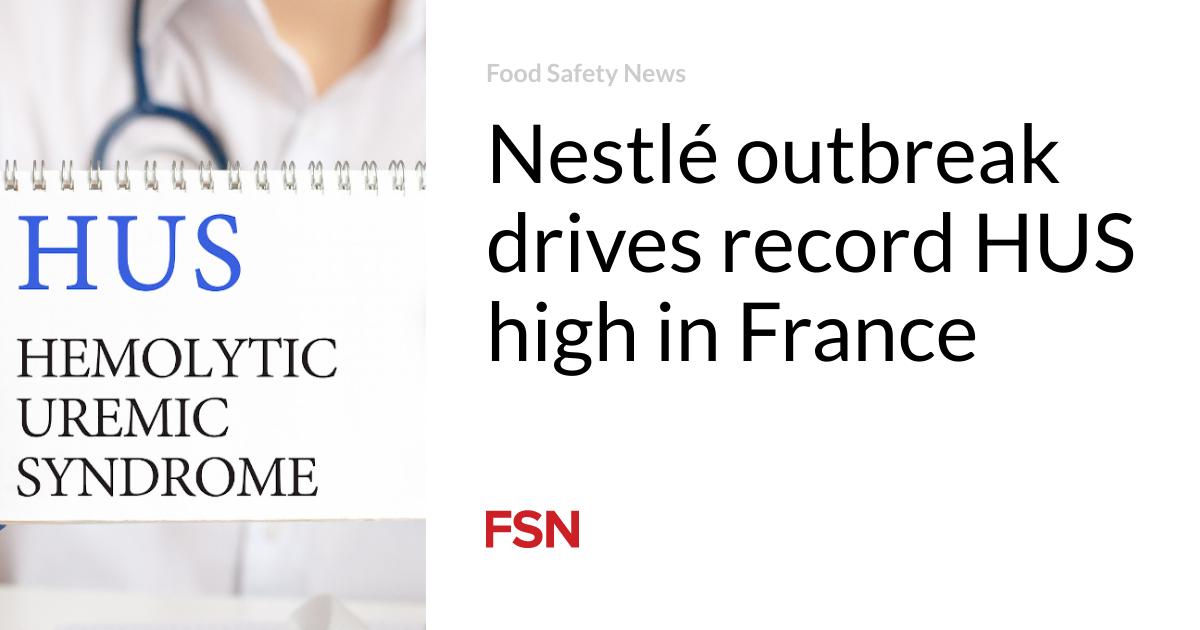Infection
Nestlé outbreak drives record HUS high in France
The number of children who suffered a potentially fatal complication of E. coli infection in France reached a record high in 2022, influenced by the Nestlé pizza outbreak, according to statistics recently released.
Hemolytic uremic syndrome (HUS), which can be a complication of E. coli infection, is a type of kidney failure that can result in lifelong, serious health problems and death.
In the outbreak caused by frozen Buitoni Fraîch’Up pizzas, 59 patients had a median age of 6. They fell ill between January and April 2022. Two children died.
Record HUS high
The 253 HUS cases in 2022 are the most since surveillance began in 1996. In 2021, 128 cases were reported. Santé publique France surveillance data on HUS only covers those younger than 15.
The sharp increase in incidence was partly driven by several outbreaks, including the one large Nestlé incident, but was also because of a lot of sporadic cases.
In 2022, there were two peaks in cases, the first in March and April because of the outbreak linked to pizzas and a second in the summer around July, when a spike is usually observed.
Like previous years, most children were younger than 3 years old and ranged from 1 month to 14. Slightly more than half were female. Incidence rates were higher in all age groups and all regions.
The median length of hospitalization was six days but ranged from 1 to 25 days for the 59 cases with this information available.
The O26 E. coli serogroup was predominant, followed by O80. The number of cases due to O80 and O157 remained comparable to 2021. From 226 cases, 114 were O26, 16 were O80, and nine were O157.
Eleven epidemiological investigations were carried out following suspected clusters of infections. It was possible to confirm a food origin twice, which resulted in recall and withdrawal measures.
For two other incidents, either a common type of food was suspected, but no confirmation was possible, or a food origin was suspected without any specific item being identified.
Outbreaks highlighted
In the frozen pizza outbreak, 55 people were infected with Shiga toxin-producing E. coli (STEC) O26:H11 and two with STEC O103:H2. Two probable cases did not have an isolated strain but had an epidemiological link with a confirmed case. Patients ranged in age from less than 1 year old to 40.
Initial investigations revealed several suspicious foods consumed by cases, including ground beef and items from the same fast-food chain, but traceability work ruled out these sources. Analysis of loyalty card data identified the frequent purchase of Buitoni frozen pizzas, and a second questionnaire for families confirmed the regular consumption of these pizzas by sick people.
The implicated range of pizzas was produced using uncooked flour. Ingredients tested positive for the outbreak strains. A total of 41 of 55 patients said they ate this brand of pizza.
In the summer of 2022, five cases of HUS were reported by a hospital in Bouches-du-Rhône. Nine confirmed STEC O26:H11 and three possible patients were eventually identified. Eleven infections occurred in the Provence-Alps-Côte d’Azur region and two in Occitanie. All patients had HUS and were hospitalized in June and July.
Investigations led to dairy products sold by l’Aupillon farm in Bouches-du-Rhône. STEC O26 was isolated from a product belonging to the same genomic cluster as strains isolated from patients. After a recall of raw milk products, no further cases were recorded.
In September 2022, Santé publique France looked into an excess of STEC O145 cases in several regions of western France. Four children with HUS and two with bloody diarrhea were infected with STEC O145:H28 in September. Epidemiological investigations pointed to vegetables, but it was not possible to find a common source of infection.
In another incident, 16 confirmed cases of STEC O157:H7 were noted in April and May 2022. There were 14 children aged 1 to 13 and two adults. Six children suffered from HUS. The source was not found.
(To sign up for a free subscription to Food Safety News, click here.)

